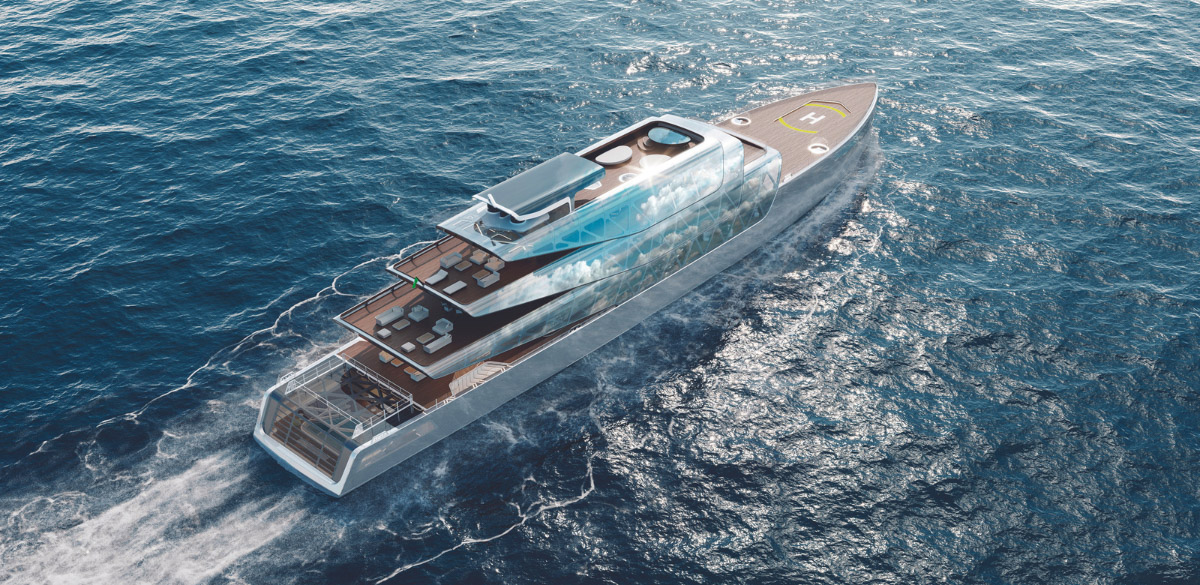Denison Yachting has announced its exclusive listing of 88m Project Pegasus, a superyacht concept designed in collaboration between Jozeph Forakis and Lateral Naval Architects.
Exclusively available as a new construction project with Denison, Project Pegasus boasts a host of world-firsts and some seriously ambitious operational functions…
With reflective ‘solar wings’, Pegasus is set to be the first 3D printed superyacht solar-electric/hydrogen hybrid with zero emissions. And if that wasn’t enough to master, plans include a multi-level “Tree of Life” hydroponic garden to provide fresh food and onboard air purification.
The conceptual project was awarded the prestigious Elite Award “reserved for the world’s leading designers and design schemes” in the “Elite Concept Award” category for global exterior and interior combined. The project also won the International Yacht & Aviation Award in the “Interior Concept” category.
Designer Jozeph Forakis commented: “I am thrilled to collaborate with Denison Yachting, one of the world’s most distinguished and respected brokerages, and Lateral Naval Architects, known for their real-world innovation, for project Pegasus. We couldn’t ask for a better foundational team to bring this dream to reality… I dreamt of creating a yacht that honours nature by becoming virtually invisible. This desire drove us to develop a zero-emissions yacht that is ‘invisible’ in both design and environmental impact. Pegasus is an ambitious, yet achievable, vision for a sustainable future in yachting. All her core technologies are based on today’s reality. It’s only a matter of time before all yachts are made this way. Today, together with Denison and Lateral, we embark on a journey to accelerate towards that future.”
For James Roy, Managing Director of Lateral Naval Architects, it was the pioneering vision of Forakis Design that appealed: “The project presents an audacious challenge in the field of structural engineering, energy architecture, and manufacturing and we look forward to exploring the boundaries of feasibility, technology readiness, and how these can be accelerated.”
The project is being represented by Denison superyacht broker Alex G. Clarke, who commented on what inspired him to become involved: “The yachting industry is filled with awe and wonder – being on the water always seems to bring a sense of calm and happiness to those around it. So it is always exciting to be linked to such a forward-thinking design. Pegasus pushes the boundaries of what is possible. To me, Pegasus will inspire an owner or shipyard to build a vessel that will be one of those iconic yachts that will bring that ‘awe and wonder’ for years to come.”
“The smart technology surrounding the concept – from fuel cells and hydroponics to zero emissions and the use of glass and solar panels – is inspiring to me. This is more than a concept and I would love to see a shipyard or owner get involved to help make her a reality. That’s our goal – to help make this project come to life,” added Clarke.
The 88m superyacht’s construction uses robotic 3D printing to create a mesh framework integrating both hull and superstructure. The result is an extraordinarily strong and lightweight structure that can be produced using less energy, material, waste, space, and time compared to ‘conventional’ superyacht construction.
The exterior design starts with a low, linear hull with a plumb bow and silver metallic finish, with the intention that this will blend in chameleon-like fashion with the water’s colours and movements. This foundation at the waterline supports the superstructure with multi-tiered, ephemeral glass wings that reflects the sky. Like some sort of alien shapeshifter, the elegant, lattice framework of the 3D-printed structure becomes visible through the reflective glass at certain angles and lighting conditions. The dramatic triangulated structure allows light to penetrate all levels of the interior while framing the views in all directions.
























0 Comments